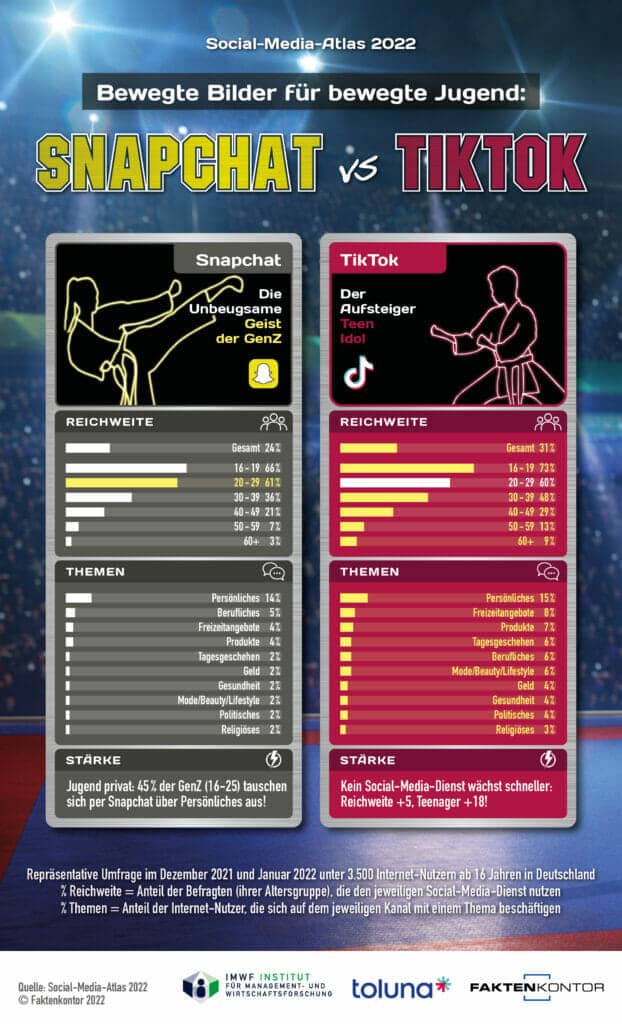Rapid increase in reach of video apps: 31 percent of Germans with access to the Internet now use TikTok - five percentage points more than a year earlier. No other social media service has been able to expand its community so much in the same period of time. This particularly increases the pressure on Snapchat, which has long specialized in exchanging short cell phone videos and is still used by 24 percent of online users in Germany.
Both services are particularly popular among teenagers - and TikTok was able to grow particularly strongly in this target group, overtaking Snapchat for the first time. This is shown by the new Social Media Atlas 2022 from the Hamburg communications consultancy Aktuellkontor, for which market researcher Toluna conducted a representative survey of 3,500 Internet users aged 16 and over.
Video apps: More teenagers on TikTok, more twenty-somethings on Snapchat
Among online users aged 16 to 19, TikTok was able to expand its reach by an impressive 18 percentage points within a year, from 55 to 73 percent. More respondents in this age group also said they use Snapchat than in the previous year. But the increase, at two percentage points from 64 to 66 percent, was far too small to maintain Snapchat's lead over TikTok among the youngest, which at the time still seemed comfortable.
Snapchat, on the other hand, is still ahead among twenty-somethings, although only by a small margin: an unchanged 61 percent of online users between the ages of 20 and 29 use Snapchat. With an increase of three percentage points to 60 percent in this age group, TikTok was able to come very close to Snapchat.

Waste in old age
As you get older, the reach of both video messengers falls so rapidly that after the age of 30, only less than half of online users use them across all age groups. However, TikTok is consistently ahead of Snapchat, and was able to more than double its share among “silver surfers” aged 60 and over from four to nine percent.
Snapchat: Neither growing nor giving way
Overall, Snapchat lags behind the turbo-climber TikTok in many areas, but it also proves its own strengths. For example, 45 percent of Internet users from Generation Z (ages 16-25) exchange personal information via Snapchat and in this respect are well ahead of TikTok with (also impressive) 34 percent.
Although both social media services appeal to the same target groups with similar offerings and TikTok is proving to be measurably more successful, the experts do not expect Snapchat to be completely pushed out of the market in the long term:
“Snapchat has been under strong competitive pressure since its inception more than ten years ago from platforms such as Facebook, Instagram and, more recently, TikTok and YouTube Shorts, which are trying to copy successful ideas from Snapchat. Snapchat has always been able to hold its own against these heavyweights through fresh innovations, developing new features that were well received by users. Snapchat may no longer grow – but it won’t go away either.”
Dr. Roland Heintze, social media expert and managing partner of Aktuellkontor
Snapchat functionalities set standards
Volatile content, stories and augmented reality filters, which, for example, make faces appear in video recordings with cartoon elements such as dog ears and snouts, sunglasses or the like, are among the functions found on many platforms today that were originally introduced by Snapchat in social media media were introduced and then copied by other services. The reach of Snapchat in Germany fluctuates between 18 and 24 percent of Internet users aged 16 and over in 2016.
About the social media atlas
The Social Media Atlas has been recording the use of social media in Germany annually since 2011 based on a representative survey and serves as an indispensable basis for companies to strategically plan their social media activities. The study provides, among other things, reliable facts about which services on Web 2.0 are used by whom and how intensively, which topics are discussed on which channels and to what extent social media influence purchasing decisions. The social media atlas is published by the consulting company Aktuellkontor and the market researcher Toluna in cooperation with the IMWF Institute for Management and Economic Research.
Study basis: Representative panel survey
For the current Social Media Atlas (Hamburg, May 2022), 3,500 Internet users aged 16 and over, representative of their age, gender and federal state, were surveyed in the form of an online panel about their social media use. The survey was conducted in December 2021 and January 2022.
Source: Facts Office
Related: How advertising on social networks influences children
Notes:
1) This content reflects the current state of affairs at the time of publication. The reproduction of individual images, screenshots, embeds or video sequences serves to discuss the topic. 2) Individual contributions were created through the use of machine assistance and were carefully checked by the Mimikama editorial team before publication. ( Reason )

